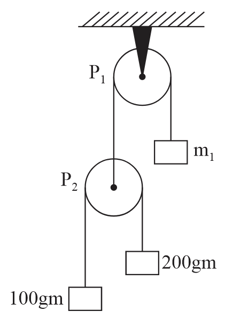Newton's Second Law of Motion
Newton's Second Law of Motion: Overview
This topic covers concepts, such as, Newton's Second Law of Motion, Limitations of F= ma, Linear Momentum, Change of Momentum, Rate of Change of Momentum, Motion of Connected Bodies, Motion on Inclined Plane & Motion on Wedges etc.
Important Questions on Newton's Second Law of Motion
The coefficient of static friction, , between block of mass and the table as shown in the figure is . What would be the maximum mass value of block so that, the two blocks do not move? The string and the pulley are assumed to be smooth and massless .
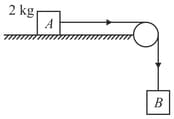
A lift weighing is moving upwards with an acceleration of . The tension in the supporting cable is
A block has been placed on an inclined plane with the slope angle block slides down the plane at constant speed. The coefficient of kinetic friction is equal to :
The pulley arrangements of the figure. (a) and (b) are identical. The mass of the rope is negligible. In (a) the mass is lifted up by attaching a mass to the other end of the rope. In (b), is lifted up by pulling the other end of the rope with a constant downward force . The acceleration of in both cases is?
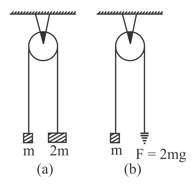
Two particles of mass each are tied at the ends of a light string of length The whole system is kept on a frictionless horizontal surface with the string held tight so that each mass is at a distance from the centre (as shown in the figure). Now, the mid-point of the string is pulled vertically upwards with a small but constant force As a result, the particles move towards each other on the surface. The magnitude of acceleration, when the separation between them becomes is
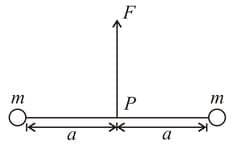
A block of mass is placed on a horizontal frictionless plane. A second block of mass is placed on it and is connected to a spring of spring constant the two blocks are pulled by distance . Block oscillates without slipping. What is the maximum value of frictional force between the two blocks?

Three identical blocks of masses are drawn by a force on a frictionless surface, then what is the tension (in ) in the string between the blocks and ?

A light string passing over a smooth light pulley connects two blocks of masses m1 and m2 (vertically). If the acceleration of the system is , then the ratio of the masses is –
A player caught a cricket ball of mass moving at a rate of . If, the catching process is completed in , the force of the blow exerted by the ball on the hand of the player is equal to
A particle of mass is subjected to a force with . What will be its initial acceleration if it is released from a point away from the origin?
Two masses and tied to a string are hanging over a light frictionless pulley. What is the acceleration of the masses when left free to move? ( )
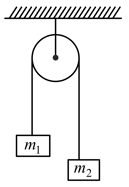
Two masses and tied to a string are hanging over a light frictionless pulley. What is the acceleration of the masses when left free to move? ( )

A machine gun fires a bullet of mass 40 g with a velocity 1200 . The man holding it can exert a maximum force of 144 N on the gun. How many bullets can he fire per second at the most?
A rocket with a lift-off mass is blasted upwards with an initial acceleration of . Then the initial thrust of the blast is nearly –
A particle starts sliding down a frictionless inclined plane. If is the distance travelled by it from time to , the ratio is
Two blocks of mass andare arranged as shown and released from rest. Assuming string and pulley to be ideal, find the separation between them after []

If acceleration of block in case is and in case is , then is
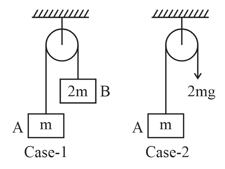
One end of the carpet is bent back, then pulled backwards with constant unit velocity, just above the part of the carpet which is at rest on the floor. What is the minimum force needed to pull if the carpet has unit length and unit mass?
A smooth uniform rope is dragged by a force on a horizontal surface. The ratio of tension and force is
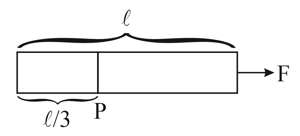
In the system of pulleys shown what should be the value of such that remains at rest: (Take )
